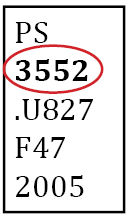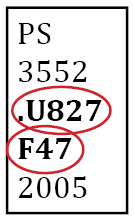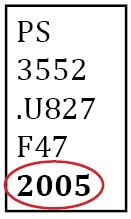Library Using Call Numbers
Skip to Main Content
A call number is like an address. It tells you where to find the book or item on the shelf.
Online, the call number shows up with other location information, like this:

Library locations: check this first!
Look at the Location first! Certain materials have specific locations in the library, so you'll go there to start looking.
AC Frost Reserves: Frost Circulation Desk (bring your call number to the desk and library staff will retrieve your item)
AC Frost Reference: Frost Level 1
AC Frost Media DVD: Frost A Level
AC Archives & Special Collections: Archives Help Desk (bring your call number to the desk and archives staff will retrieve your item)
Other locations are listed on Find it in Frost and Branches & Affiliates.
How to read a call number in four steps
Step One

Start with the first two letters. Read these alphabetically, starting with the first letter.
for example: NX, PA, PB, PC, PD, PE.........QA, QB, QC, etc
They tell you the floor the item is on, and the section of shelves it is in. These letters also tell you the subject of the item.
Sometimes, the call number will start differently. This tells you that the item is in a special section of the library:
x/xx = Oversize
000-999 = Dewey
Step Two

Next, read the first set of numbers. Read these as whole numbers (ex: 352 before 3,552).
This tells you the shelf the item is on.
Step Three

Read the next set of letters and numbers alphabetially, with the numbers as decimals.
for example: .U8, .U82, .U8224, .U83, .U85, .U876
There may be multiple lines with letters and numbers (U827, then F47) -- read each line in order, matching line-by-line with the books on the shelf as you go.
Step Four

After the year, there may also be a line that specifies the item collection.
AC/Main = main collection
REF = Reference
Additional questions
I didn't find my item on the shelf -- now what?
Please come to the Circulation Desk and let us know -- if a book is missing, we can search for it for you.
What does it mean if it says Reserves next to my item?
Reserves are materials and resources that professors have identified to use for a class. Reserves material may be requested at the Circulation Desk in the Lobby and may be checked out for a maximum of 4 hours with no renewals.
How can I browse for a specific genre (fiction, mystery, etc)?
This can be tricky! It’s usually easiest if you use the advanced search option from the Books & Media tab. You could start by searching for a specific title in that genre, and then look at the item page. Items usually have subject terms attached to them, and sometimes these are genres (ex: fantasy, science fiction, etc.). You can click on a subject term to search by that term.
What does Library Use Only mean?
These materials can only be used in the library building; they cannot be checked out to be removed.
I found an item record, but there is a date listed under Due Date. What does that mean?
This means that the item has been checked out to another patron; the date is when the patron is expected to return the item. If you need an item sooner than this date, you can use the Request Item button, which will issue a recall to the patron (it will ask them to return it sooner). You can also talk to anyone at the Circulation or Reference desks.
What does Billed mean?
"Billed" means that the item has not been returned and the patron has been charged for it. Since we can't determine when this item will return, please use the Library Request Service to request a copy from another library.
Why are libraries organized this way?
Libraries organize their materials using classification systems and call numbers, as a way to bring lots of complex materials together in a coherent way. When you think about organizing thousands of items, with different types of works (encyclopedias, translations, criticisms, etc.), each one often covering multiple specific topics, it can get complicated very quickly!
Classification systems and call numbers group related material together, encouraging browsing. If you find a book that interests you on a shelf, look around! There will be related books in the same area.
I have other questions!
Please stop by the Reference Desk with any questions -- we’ll be happy to answer them! You can also check our Library FAQ.